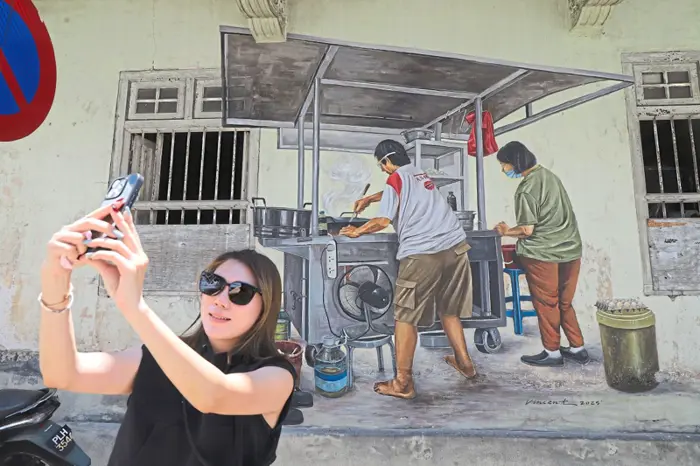GEORGE TOWN (ANN/THE STAR) – Malaysia’s Penang icon has been etched not only in memory but now in paint, as the legendary barefoot char koay teow hawker, Tan Bak Juah, 71, finds himself the subject of a striking new street mural along McNair Street — just a wok’s throw from the bustling Cecil Street market where he has plied his trade for decades.
The mural, painted by renowned local artist Vincent Phang, 39, captures Tan in his element — barefoot, wok in hand, flames licking the base of his charcoal stove — a scene as familiar to market-goers as the scent of fried noodles wafting through the air each morning.
Phang, known for more than 100 murals across the country including in Kuala Lumpur and Melaka, spent ten days completing the tribute with permission from the building’s owner.
For him, this piece is more than just art — it’s an homage to a vanishing breed of hardworking hawkers who have helped shape Penang’s culinary identity.
“Many of these hawkers have dedicated their entire lives to perfecting their craft,” Phang said.
“Tan is a third-generation hawker. I hope that through murals like this, people will remember not just the food, but the faces and stories behind it.”

And Tan’s story is one served with extra helpings of history. His father, the late Tan Ah Eng, first began selling char koay teow nearly 80 years ago from a humble wooden cart.
The elder Tan would station himself on Tye Sin Street — fondly known as Fourth Street among the local Hokkien-speaking community — frying up hearty breakfasts before pushing the cart through McNair Street to Cecil Street each afternoon.
Tan, who was just 12 when he began learning the trade at his father’s side, recalled those early years fondly.
“My father was the one who started going barefoot while cooking,” Tan said with a chuckle at his stall on Friday morning. “It wasn’t for tradition or show. The charcoal stove gives off intense heat, and being barefoot helps to release some of that heat through the feet — it also lets you feel the coolness of the cement floor beneath.”
That method stuck with him. Even after he officially took over the family business 20 years ago — following a stint by his older brother — Tan has continued to fry barefoot, day in and day out, six days a week.
From 6.30am until 3pm daily (except Thursdays), the couple — Tan and his wife, Khoo Siew Luang, 63 — work seamlessly together at their stall nestled in the food court of the Cecil Street market.
Khoo handles the flurry of orders from loyal customers and curious foodies alike, while Tan keeps his seasoned wok sizzling, churning out plate after plate of smoky, fragrant char koay teow.
Regulars often praise not only the dish’s deep flavours but the consistency with which it is prepared — a signature only time and experience can deliver.
With changing times and younger generations less inclined to enter the hawker trade, stories like Tan’s are increasingly rare. Phang’s mural, then, is more than a celebration — it’s a preservation.
“The mural reminds us that behind every beloved local dish is a person, a family, a history,” Phang said. “Hawkers like Tan are part of Penang’s living heritage.”
Indeed, long after the wok cools and the shutters close, Tan’s barefoot legacy now lives on — not only in the memories of satisfied diners but also in bold strokes on a shophouse wall, proudly watching over McNair Street.


